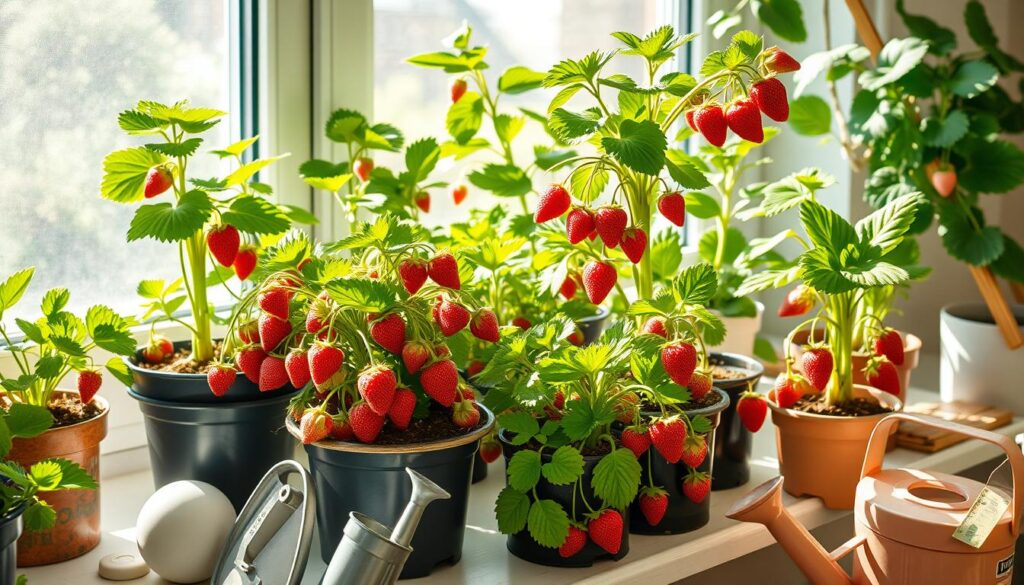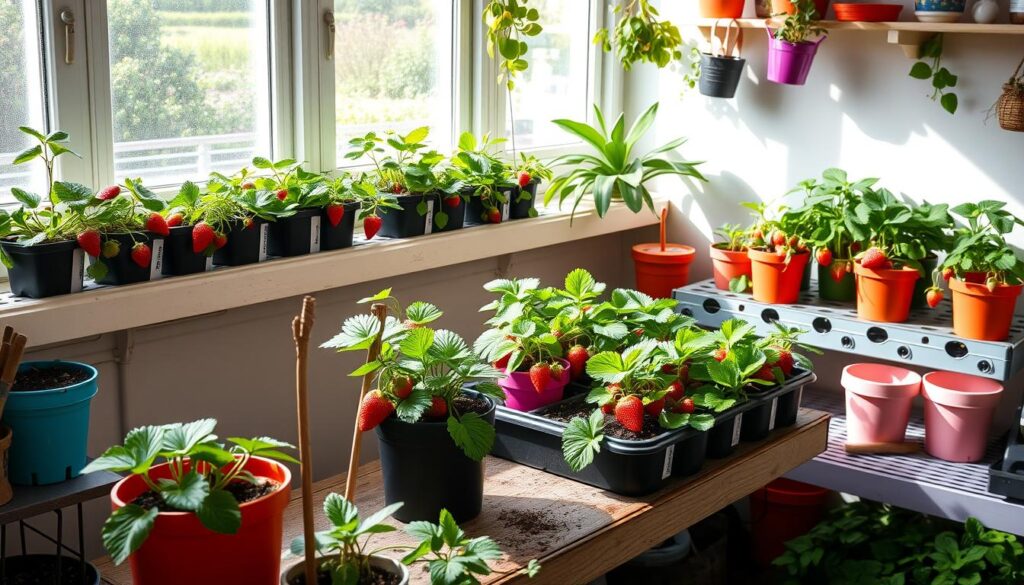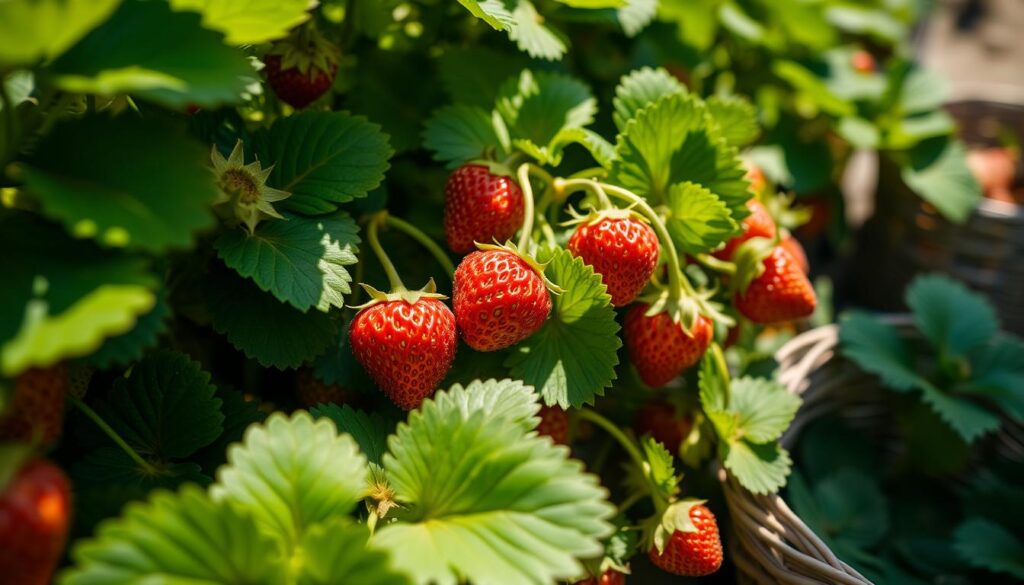Welcome to indoor gardening, where you can grow delicious strawberries at home. It’s a great way to start gardening indoors. With a little care, you’ll soon enjoy fresh strawberries.
Indoor gardening lets you grow your own food, starting with strawberries. It’s easy and keeps you supplied with healthy strawberries all year. It’s fun and rewarding for gardeners of all levels.

Growing strawberries indoors brings many benefits. You get fresh air, better mental health, and a sense of achievement. Plus, you can enjoy strawberries year-round. So, why not start today and see the benefits for yourself?
Key Takeaways
- Indoor gardening is easy and fun
- Growing strawberries at home is a great way to get started
- Fresh, healthy strawberries can be grown all year round
- Indoor gardening has many benefits, including fresh air and improved mental health
- With the right equipment, anyone can grow delicious strawberries at home
Why Growing Strawberries at Home Is the Perfect Choice
Growing strawberries at home is rewarding. It gives you a steady supply of fresh, tasty strawberries. You can enjoy homegrown strawberries all year, whenever you want.
Some key benefits of growing strawberries at home include:
- Access to fresh, healthy strawberries all year round
- Cost savings compared to buying strawberries at the store
- The ability to control the growing conditions and ensure your strawberries are free of pesticides and other chemicals
Health Benefits of Home-Grown Strawberries
Homegrown strawberries are not just tasty. They’re also full of nutrients and antioxidants. Eating them can boost your immune system and reduce inflammation.
Cost Savings Over Store-Bought Berries
Growing your own strawberries can save you money. With the right setup, you can have a year-round harvest. This means less reliance on store-bought berries.
Year-Round Growing Possibilities
With the right conditions and equipment, you can grow strawberries all year. This ensures a constant supply of fresh, healthy strawberries, no matter the season.
Essential Equipment for Indoor Strawberry Growing
To start growing strawberries indoors, you’ll need some key equipment. You’ll need containers that are at least 5-7 gallons in size. This size is important for the roots to grow well, a crucial part of container gardening.
You’ll also need a well-draining potting mix, a watering system, and a light source. Strawberries need a lot of light to grow well. If you don’t have a sunny windowsill, consider using LED grow lights.
Some of the key indoor gardening equipment you’ll need includes:
- Containers with good drainage
- A high-quality potting mix
- A watering system, such as a drip irrigation system
- A source of light, such as LED grow lights
Think about the space where you’ll grow your strawberries. It should be well-ventilated and have enough room for your plants. With the right equipment and care, you can enjoy homegrown strawberries all year.
Investing in the right container gardening equipment is key. It helps create a thriving indoor garden with fresh, healthy strawberries. Choose equipment made for indoor gardening for the best results.
Choosing the Right Strawberry Varieties for Indoor Growing
Choosing the right strawberry variety is key for a good indoor harvest. There are many varieties, each with its own growth habits, fruit size, and disease resistance. Ever-bearing strawberries are great for indoor growing because they produce many crops.
June-bearing strawberries, however, produce one big crop in spring. They’re better for outdoor growing. For indoor growing in containers, look for compact or dwarf varieties. ‘Albion’, ‘Camarosa’, and ‘Seascape’ are popular choices.
Ever-Bearing vs June-Bearing Varieties
Ever-bearing strawberries are perfect for indoor growing. They produce many crops and handle heat and humidity well. June-bearing strawberries, on the other hand, produce one big crop in spring. They’re better for outdoor growing.
Best Varieties for Container Growing
For growing in containers, choose compact or dwarf varieties. Some top picks include:
- ‘Albion’: A compact, ever-bearing variety that produces large fruits
- ‘Camarosa’: A dwarf, June-bearing variety that produces high yields
- ‘Seascape’: A compact, ever-bearing variety that produces large fruits and is resistant to disease
Climate Considerations for Variety Selection
When picking a strawberry variety for indoor growing, consider the climate. Some varieties handle heat or cold better than others. Choose a variety that fits your indoor growing conditions for a great harvest.
| Variety | Growth Habit | Fruit Size | Disease Resistance |
|---|---|---|---|
| ‘Albion’ | Compact | Large | High |
| ‘Camarosa’ | Dwarf | Medium | Medium |
| ‘Seascape’ | Compact | Large | High |
Setting Up Your Indoor Growing Space
Creating the perfect indoor gardening setup for strawberries involves several key factors. They need specific temperatures, humidity, and light to grow well. Daytime temperatures should be between 65-75°F (18-24°C), and nighttime around 55-65°F (13-18°C). High humidity, over 50%, is also crucial for their health.
To set up the ideal indoor gardening setup, focus on these important elements:
- Lighting: Make sure your strawberries get enough light, whether from the sun or grow lights.
- Temperature control: Your growing space should keep the right temperature for strawberries.
- Humidity management: Use a humidifier or other methods to keep humidity high.
By controlling these factors, you can create a perfect environment for your strawberries. Always check the specific strawberry growing conditions for your variety, as some may need special care. With the right indoor gardening setup and attention, you’ll enjoy a rich harvest of tasty strawberries.

By following these tips and setting up a well-thought-out indoor gardening setup, you’re on your way to growing delicious strawberries indoors all year round. Happy growing!
| Factor | Ideal Range |
|---|---|
| Daytime Temperature | 65-75°F (18-24°C) |
| Nighttime Temperature | 55-65°F (13-18°C) |
| Humidity | Above 50% |
The Complete Guide to Growing Strawberries at Home
Planting is a key step in strawberry care. You can grow strawberries from seeds or use runners. Seeds are cheaper but take longer to bear fruit.
Strawberries need about 1-2 inches of water per week. This can come from rain or irrigation. Here are some watering tips:
- Water your strawberries in the morning to allow the plants to absorb the water throughout the day.
- Avoid overwatering, which can lead to root rot and other problems.
- Use a drip irrigation system or soaker hose to deliver water directly to the roots.
Light and Temperature Control
Strawberries need lots of light to grow well. They prefer cooler temperatures, between 60-70°F. Here’s a table with the ideal growing conditions:
| Factor | Ideal Condition |
|---|---|
| Light | Full sun to partial shade |
| Temperature | 60-70°F |
| Water | 1-2 inches per week |
Follow these tips and provide the right conditions. You’ll enjoy a rich harvest of tasty strawberries. Growing strawberries from seeds is a rewarding experience.
Nutrient Management and Fertilization Tips
Strawberry plants need regular strawberry fertilization to grow well. A balanced fertilizer with a 10-10-10 NPK ratio works well. Adding potassium helps with fruiting. Nutrient management is key for healthy plants, and manure or compost is great for slow nutrient release.
Here are some strawberry fertilization tips:
- Use a balanced fertilizer during the growing season.
- Add potassium-rich fertilizers to help with fruiting.
- Try organic fertilizers like compost or well-rotted manure for slow nutrient release.
Good nutrient management stops common problems like nutrient deficiencies. These issues can harm strawberry plant health and productivity. Follow these tips to give your strawberry plants the nutrients they need for the best growth and fruit.
Common Problems and Solutions
Growing strawberries can come with challenges like pests and diseases. These problems can hurt your plants’ health and how well they grow.
To fight pests, try organic methods like introducing helpful bugs or using neem oil. For diseases, make sure plants have enough air and remove sick ones to stop disease spread.
Pest Management Strategies
- Use organic pest control methods, such as introducing beneficial insects
- Apply neem oil to control aphids and other pests
- Remove weeds and debris to reduce the risk of pest infestations
Disease Prevention and Treatment
Keeping your strawberry plants healthy is key. Check them often for diseases like powdery mildew or botrytis. Act fast to stop disease from spreading.
Troubleshooting Growth Issues
Problems with growth often come from not enough light, water, or nutrients. Make sure your plants get enough of these to grow well.
| Common Problem | Solution |
|---|---|
| Pests | Use organic pest control methods |
| Disease | Ensure good air circulation and remove infected plants |
| Growth Issues | Provide sufficient light, water, and nutrients |
Harvesting and Storage Methods
Timing is key when picking strawberries. They’re ready when they’re bright red and smell sweet. Harvesting at the right time ensures the best taste and texture.
After picking, store strawberries in the fridge to keep them fresh. Proper storage is vital to keep strawberries fresh longer.
Here are some tips for harvesting and storing strawberries:
- Check the strawberries daily for ripeness, as they can quickly become overripe and spoil.
- Handle the strawberries gently to avoid bruising or damaging them.
- Store the strawberries in a cool, dry place, away from direct sunlight.
To keep strawberries fresh all year, you can freeze, make jam, or dehydrate them. These methods help you enjoy your strawberries throughout the year. By following these tips, your strawberries will stay fresh and tasty longer.

Mastering strawberry harvesting and storage lets you enjoy a full harvest. This way, you can make the most of your homegrown strawberries.
| Storage Method | Shelf Life |
|---|---|
| Refrigeration | 3-5 days |
| Freezing | 6-8 months |
| Dehydrating | 6-12 months |
Creative Ways to Use Your Homegrown Strawberries
With your own fresh strawberries, you can try new recipes. A favorite is strawberry shortcake, with fresh strawberries, whipped cream, and biscuits. You can also make jams, preserves, and sauces.
Homegrown strawberries add flavor and freshness to dishes. Add them to salads, smoothies, or yogurt. The options are endless, and you can find new favorites.
- Making a strawberry sorbet or ice cream
- Adding them to your favorite salad dressing or vinaigrette
- Using them as a topping for pancakes or waffles
- Blending them into a refreshing strawberry smoothie
Enjoy your strawberries in creative ways. Make a classic strawberry shortcake or try something new. You’ll love the sweet taste of your homegrown strawberries.
| Strawberry Recipe | Ingredients | Instructions |
|---|---|---|
| Strawberry Shortcake | 2 cups fresh strawberries, 1 cup whipped cream, 1 cup sweet biscuits | Slice the strawberries and layer them with whipped cream and sweet biscuits |
| Strawberry Jam | 2 cups fresh strawberries, 1 cup sugar, 1 tablespoon lemon juice | Combine the strawberries, sugar, and lemon juice in a pot and bring to a boil, then reduce heat and simmer until the jam thickens |
Conclusion: Enjoying the Fruits of Your Labor
Growing strawberries at home is a rewarding experience. It lets you enjoy the fresh, delicious flavors of your own produce. With the right setup and care, you can have a lot of juicy, nutritious berries all year.
Whether you want to save money, eat healthier, or just enjoy growing your own food, growing strawberries at home is a great choice. This article has given you the knowledge and tools to grow a thriving strawberry patch at home.
From picking the best varieties to managing nutrients and pests, you’re ready for any challenge. You’ll have a rewarding growing experience.
So, what are you waiting for? Start your journey to homegrown strawberry benefits and enjoy the fruits of your labor. Pick, prepare, and enjoy these delightful berries. You’ll also save money and improve your health. Happy growing!
FAQ
What are the health benefits of homegrown strawberries?
Homegrown strawberries are full of nutrients and antioxidants. They are a great source of vitamin C, fiber, and other vitamins and minerals. These can help improve your overall health.
How much money can I save by growing my own strawberries?
Growing your own strawberries can save you a lot of money. It’s cheaper than buying them from the store. Plus, you’ll have fresh berries all year.
Can I grow strawberries year-round?
Yes, you can grow strawberries all year with the right setup. Indoor growing lets you control the environment. This ensures your plants thrive all year.
What types of containers are best for growing strawberries indoors?
Choose containers that are at least 5-7 gallons for indoor growing. They should be well-draining and have good air circulation. This keeps your plants healthy.
What are the differences between ever-bearing and June-bearing strawberry varieties?
Ever-bearing varieties produce many crops throughout the season. June-bearing varieties have one big crop in spring. For indoor growing, pick compact varieties bred for small spaces.
How do I properly water and fertilize my indoor strawberry plants?
Strawberries need 1-2 inches of water a week. Use a balanced fertilizer (10-10-10 NPK) and add potassium for fruiting. Organic fertilizers like compost are also good.
How do I prevent and manage pests and diseases on my indoor strawberry plants?
Use organic pest control for pests like aphids and slugs. For diseases like powdery mildew, ensure good air circulation and remove infected plants.
When is the best time to harvest my homegrown strawberries?
Pick strawberries when they’re bright red and smell sweet. Harvesting regularly encourages more fruit and prevents overripening.
How can I store and preserve my homegrown strawberries?
Store strawberries in the fridge to keep them fresh. You can also freeze, make jam, or dehydrate them. This way, you can enjoy them all year.

